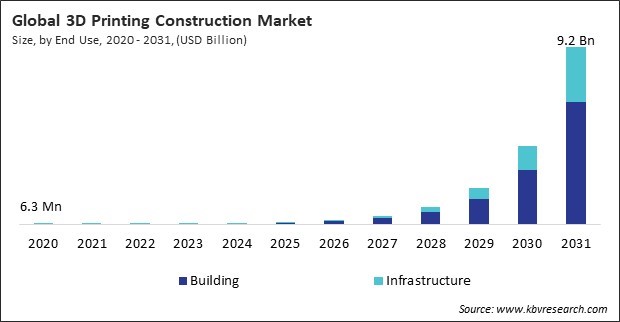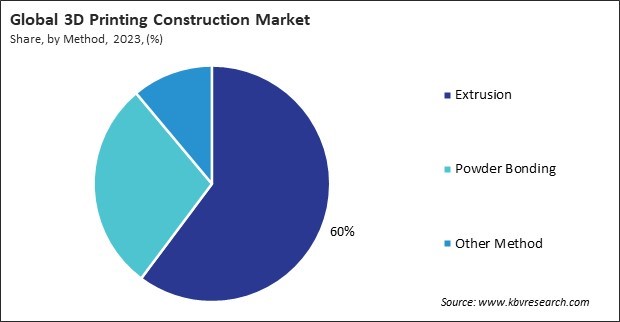“Global 3D Printing Construction Market to reach a market value of 9.2 Billion by 2031 growing at a CAGR of 101.9%”
The Global 3D Printing Construction Market size is expected to reach $9.2 billion by 2031, rising at a market growth of 101.9% CAGR during the forecast period.
The Asia Pacific region witnessed 40% revenue share in this market in 2023. Asia Pacific’s dominance in the market is driven by rapid urbanization, a growing demand for affordable housing, and increasing investments in construction technology. Countries like China, India, and Japan are in charge of adopting 3D printing technologies for building and infrastructure projects. The region’s construction industry is increasingly looking for innovative, sustainable solutions, and 3D printing offers a way to address challenges such as labor shortages, material wastage, and speed in construction.

The increasing global demand for affordable housing has become a primary driver for this market. As the world’s population grows, particularly in developing countries, there is a heightened need for housing solutions that are both affordable and scalable. Traditional construction methods often involve significant labor costs, material waste, and time consumption, making housing projects unaffordable. Hence, the rising demand for affordable and sustainable housing solutions drives the market's growth.
Additionally, Sustainability in construction is becoming increasingly important as the global construction sector is one of the largest contributors to carbon emissions and material waste. With 3D printing technology, construction projects can achieve greater sustainability through reduced material waste, lower carbon footprints, and the potential use of sustainable or recycled materials. Thus, the construction industry's growing focus on sustainability and environmental responsibility propels the market's growth.
However, While 3D printing technology presents a promising future for construction, one of the main barriers to adoption is the high initial capital investment required for 3D printing equipment and infrastructure. Acquiring large-scale 3D printers, setting up printing facilities, and purchasing necessary materials can be prohibitive, especially for small to mid-sized construction firms. Additionally, the need for specialized training to operate the technology adds to the upfront costs. Thus, high initial capital investment for 3D printing equipment and infrastructure hampers the market's growth.
By end use, the 3D printing construction market is divided into building and infrastructure. The infrastructure segment procured 29% revenue share in this market in 2023. While the infrastructure segment holds a smaller share than building construction, it is rapidly growing due to the unique advantages of 3D printing in creating complex infrastructure components such as bridges, roads, and utilities.
Based on method, the 3D printing construction market is divided into extrusion, powder bonding, and others. The powder bonding segment attained 29% revenue share in this market in 2023. Powder bonding involves fusing layers of powdered material using a binding agent or heat, making it ideal for producing highly detailed and precise components in construction. This method is especially beneficial for creating intricate designs, customized parts, and applications requiring advanced material properties, such as manufacturing structural elements or decorative features.

On the basis of material type, the 3D printing construction market is segmented into concrete, metal, composite, and others. In 2023, the metal segment attained 29% revenue share in this market. Metal 3D printing is gaining traction due to its high strength, precision, and ability to create intricate, custom components for construction projects. Metals like titanium, steel, and aluminum are used in construction applications that demand superior material performance, such as structural supports, facades, and specialized elements in commercial and industrial buildings.
Free Valuable Insights: Global 3D Printing Construction Market size to reach USD 9.2 Billion by 2031
Region-wise, the 3D printing construction market is analyzed across North America, Europe, Asia Pacific, and LAMEA. In 2023, the North America region generated 30% revenue share in this market. North America has seen a steady rise in the adoption of 3D printing technologies for construction, with the United States leading the market. The region’s growth is driven by an increasing emphasis on sustainable building practices, demand for faster construction timelines, and innovation in design.
| Report Attribute | Details |
|---|---|
| Market size value in 2023 | USD 38.6 Million |
| Market size forecast in 2031 | USD 9.2 Billion |
| Base Year | 2023 |
| Historical Period | 2020 to 2022 |
| Forecast Period | 2024 to 2031 |
| Revenue Growth Rate | CAGR of 101.9% from 2024 to 2031 |
| Number of Pages | 210 |
| Tables | 350 |
| Report coverage | Market Trends, Revenue Estimation and Forecast, Segmentation Analysis, Regional and Country Breakdown, Porter’s 5 Forces Analysis, Company Profiling, Companies Strategic Developments, SWOT Analysis, Winning Imperatives |
| Segments covered | End Use, Method, Material Type, Region |
| Country scope |
|
| Companies Included | Stratasys, Ltd., 3D Systems Corporation, Materialise NV, Sika AG, Skanska Group, PCL Industrial Constructors, Inc., MX3D B.V., ABB Ltd., CEAD B.V., and Constructions-3D |
By End Use
By Method
By Material Type
By Geography
The Market size is projected to reach USD 9.2 billion by 2031.
Rising Demand For Affordable And Sustainable Housing Solutions are driving the Market in coming years, however, High Initial Capital Investment For 3D Printing Equipment And Infrastructure restraints the growth of the Market.
Stratasys, Ltd., 3D Systems Corporation, Materialise NV, Sika AG, Skanska Group, PCL Industrial Constructors, Inc., MX3D B.V., ABB Ltd., CEAD B.V., and Constructions-3D
The expected CAGR of this Market is 101.9% from 2024 to 2031.
The Extrusion segment led the maximum revenue in the Market by Method in 2023, thereby, achieving a market value of $5.4 billion by 2031.
The Asia Pacific region dominated the Market by Region in 2023, and would continue to be a dominant market till 2031; thereby, achieving a market value of $3.8 billion by 2031.
Our team of dedicated experts can provide you with attractive expansion opportunities for your business.

 Drivers
Drivers
 Restraints
Restraints
 Opportunities
Opportunities
 Challenges
Challenges
